10 Shady Perennials that Pass the Test of Time
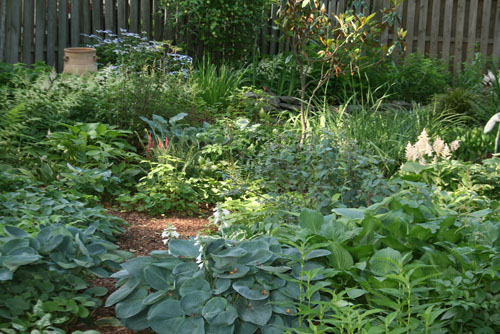
We were throwing around ideas in the information nerve center of Behnke Nurseries this morning, about who might write what. One of my coworkers recently bought a home with a shady yard, and she was looking for advice on what to plant. I thought it might be time to review what has been successful in my shady garden. Giving literally “sage advice” to other gardeners is one of the few pluses I can see to getting older, may as well take advantage of it!
We’ve been in the house for 31 years, so some plants have passed the “test of time.” I’m mostly interested in perennials, which I think are the evolutionary peak of gardening. But I am a little odd, that said. Here are ten.
First, my lot is a little less than a quarter acre, and when the home was built in around 1958, many of the trees on the lot were saved. So we have some really big oaks, tulip poplars, and pignut hickories (and aren’t you glad you weren’t stuck with that moniker? You could be Delilah Pignut-Hickory, of the Atlanta Pignut-Hickories). That’s an indication that the lot stays on the dry side; no maples—that means no trees with really aggressive surface root systems. I’m pretty lazy, so I dig the smallest hole possible and cram the plant into it. I consider that to be a challenge thrown down to the plant, which some of them actually answer. The back is fenced and I have not yet had a deer problem there; the front has had a little deer pressure, but I’ve managed through careful use of repellent and coupons to convince them to feed at the neighbors’.
So:
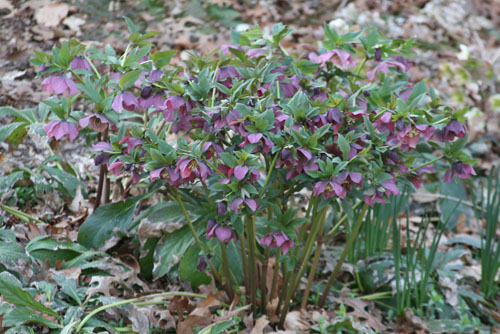
Hellebores, deer resistant; not native. Really, the perfect plant. Depending on the type, blooms begin in late November or mid-March, and go on for months. Evergreen foliage (I like to cut off the old leaves as the new ones come up in April or May, as they usually have some winter burn.) Care free. I have hellebores that came from Mr. Behnke’s garden thirty years years ago. They seed gently around the yard over time, so you will get patches of them. The newer varieties are worth the extra money, with more blooms, reliable color selection, and flowers that face forward and even upward a bit, instead of bending toward the ground as if they are embarrassed to be such great plants. I am very fond of the variety ‘Pink Frost.’

Epimedium, or Barrenwort: deer resistant; not native. Evergreen ground cover for dry soil. They almost always get winter burn, and around April 1 I cut them to the ground with a hedge trimmer, so that the fleeting flowers are more easily seen. Like little columbines. They don’t last more than a few days, but they are nice, and the variety ‘Sulphureum’ is a heavy bloomer, with leaves that turn reddish-purple in the fall. They are generally small and expensive in pots, and take a couple of years to get going, but they are very reliable.
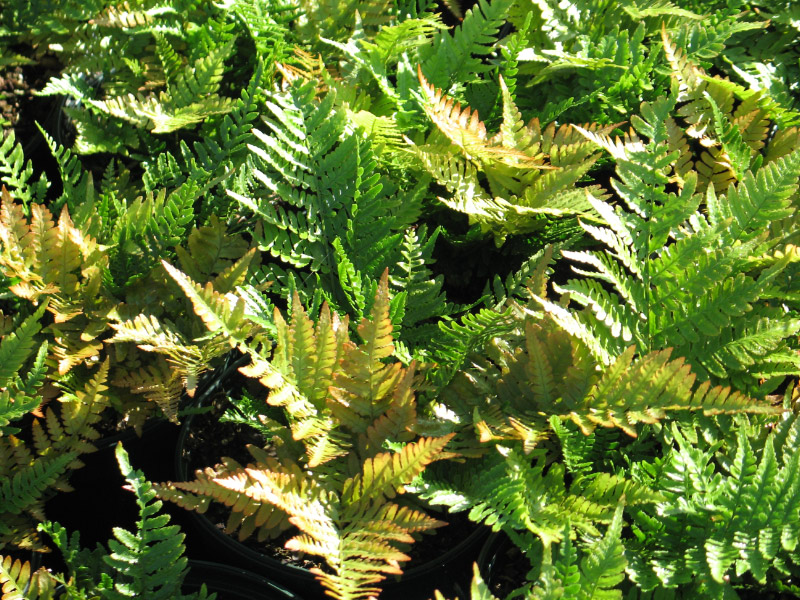
Christmas Ferns: deer resistant, native, and Autumn Ferns; not native. The best ferns for dryer shade, they tolerate low light and are evergreen, although the Christmas Fern in particular lies down in the winter and isn’t real showy in the colder months. The bronzy young growth on Autumn Ferns can be spectacular. My Autumn Ferns are in a really poorly lit spot, and they just are just as happy as can be.
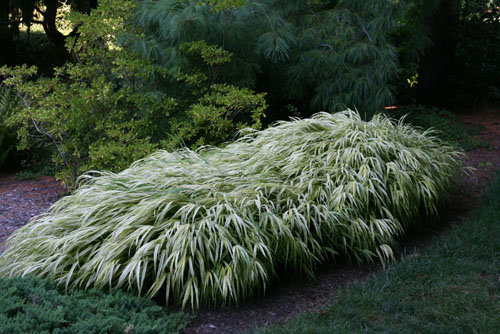
Japanese Forest Grass: Hakonechloa: deer resistant; not native. Best grass around. I have four types, I think the best is ‘Aureola’, with beautiful golden foliage. Great next to ponds, on either side of a walkway, in container gardens, cascading over a low wall…

Hostas: not native; deer candy. Deer love hostas. The “Queen of the Perennial Shade Garden.” Deer consider hostas a constitutional right. I have moved many of mine to the back yard, and I spray the rest with repellent regularly. I have hostas that are thirty years old, too. They live in fear of the cloven-hooved devils, but every garden should have some. The old ‘Royal Standard’ has plain green, one might say boring, leaves, but the fragrant white flowers in late summer are quite nice. There are another 5,000 or so other varieties to select from as well. In season at Behnkes, we usually have around a hundred types in stock. I have maybe thirty varieties at home; other favorites include ‘Sum and Substance’ and ‘Sagae.’ If deer are a problem, the cute-as-a-button minis do fine in containers kept close to the house.
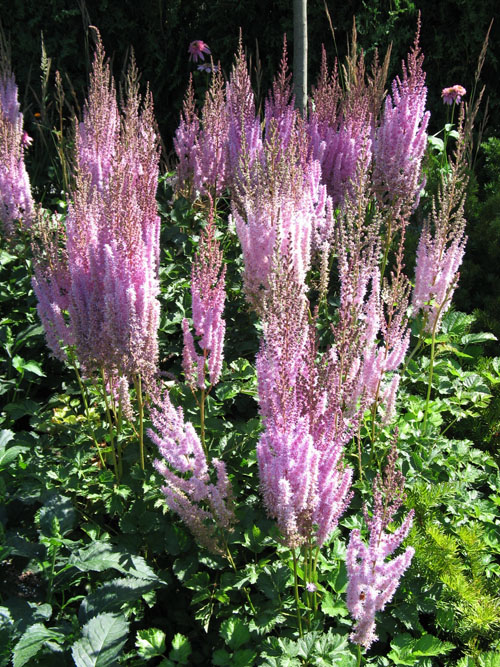
Astilbe: somewhat deer resistant, not native. These need irrigation in summer. They bloom for a couple of weeks in late spring/early summer, with feathery plumes. Red, white, pink or purple. If they do go dry and wilt, they may die back to the ground till next spring, but they seem to pop back okay. The “chinensis” varieties are said to take drying out better than the rest. Color in shade is a problem in summer (that is, there aren’t many blooms around) and the astilbes do a nice job of carrying flowering into June and even early July, if you use an assortment of varieties.
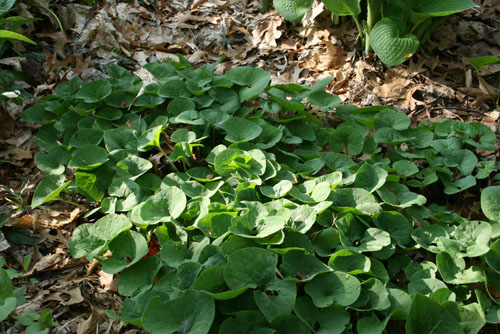
Wild Ginger, Asarum canadense: native, deer resistant. These are a little hard to get going in a pot, and what you see for sale will seem a little scrawny for the price. Given a few years, though, they will spread and make a nice, full, low ground cover. They bloom for a week or two in April, but since they are pollinated by ants, you have to be really short to appreciate them. Little liver-colored bells under the leaves. They are really grown for the round leaves and ability to cover the earth. Even though not evergreen, they grow densely enough to hold the soil in the winter.
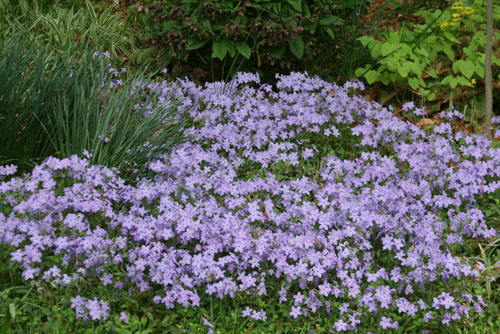
Phlox stolonifera, Creeping Phlox: native, deer resistant. Best of the shade tolerant phloxes, I find that siting is important. It likes some morning sun (as does almost everything, that said) and soil that doesn’t get bone dry. I irrigate in the summer if things get bad, and the Phlox probably needs that. I also find that the variety ‘Sherwood Purple’ is the only one that has hung on tenaciously for me.

Polygonatum, Solomon’s Seal: not deer resistant; native or non-native. Really, the variegated Asian one is more ornamental and easier to come by. I have both, and the native is a pleasant plant, but the variegated makes a pretty dense tall ground cover and has a pink tinge when it first comes up in the spring that is really striking. The little white flowers are okay, but the foliage is the primary reason to grow this.
So, as a certified old-timer, this is what has worked well for me. Give them a shot and let me know in thirty years how they have done for you. I’ll save a rocker for you.
By Larry Hurley, Buyer/Perennials Specialist

This Post Has 0 Comments